

Structures in chemical and petrochemical facilities are often located in areas that may be subjected to blast loading. Building in those areas typically have non-structural components located along the exterior and interior of the walls and roof. Examples of non-structural components located on the building exterior include windows, doors, wall mounted AC units, mechanical equipment on roof, etc. While non-structural components inside the building include lights, furniture, storage racks, hanging equipment, loose articles, etc.
In explosion related events, significant amounts of injuries are a result of glass and interior non-structural items that become projectiles and impact building occupants. As a pressure wave from a blast impacts the exterior of a building, the wall and roof components are rapidly accelerated inward. Equipment or contents mounted on or in contact with the exterior façade are also accelerated and may be dislodged and projected as debris. Items anchored to the ceiling structure can be thrown vertically with the initial forward deflection of the supporting member or break free from their supports and become falling debris hazards.
Therefore, evaluation and mitigation of non-structural debris in a building subjected to blast load is crucial to prevent or minimize potential hazards to personnel in buildings. The response of the non-structural components is obtained by associating structural component response to anticipated debris hazards. This paper intends to provide design retrofits recommendations based on accident investigation experience at chemical and refining facilities and engineered solutions for typical hazards commonly observed at chemical and petrochemical facilities.
